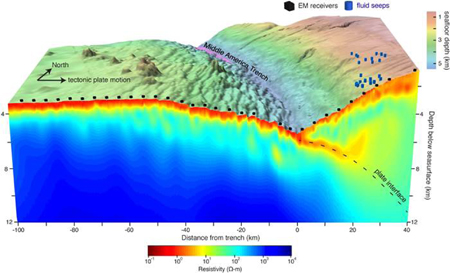Electromagnetic imaging
of water-rich faults and melt-rich asthenosphere
at the Middle America Trench
By:
Samer Naif
Scripps Institution of Oceanography
Click for a Live Broadcast.

Abstract
Quantifying the flux of water transported by oceanic plates and the distribution of fluids released during subduction is critical to understanding the pattern of seismic coupling at the plate interface and the cycling of water between the solid and fluid Earth.
Electromagnetic (EM) methods are ideally suited to map porosity and fluid pathways to help elucidate the hydrogeology of subduction zones. In 2010, Scripps performed the Serpentinite, Extension, and Regional Porosity Experiment across the Nicaragua Trench (SERPENT).
We deployed 50 ocean-bottom EM receivers along a 280 km profile that spanned the abyssal plain, trench-outer rise, and forearc slope at the Middle America Trench. In this presentation, I will discuss results from 2-D inversion of both the passive magnetotelluric (MT) and controlled-source EM (CSEM) data.
The MT data led to the surprising discovery of a thin high conductivity channel seaward of the trench at 45-70 km depths. Its resistivity signature requires enough water to induce melting and leads us to conclude the origin of the anomaly to be partial melt.
The CSEM data reveal fluid-rich pathways along bending faults in the incoming crust, the complete subduction of the incoming sediments that define the plate interface, and the migration of fluids from the plate interface to the overlying plate. We infer porosity from resistivity to show that: 1) the incoming crust subducts 60% more pore water than previous estimates, and 2) the subducted sediment porosity decays exponentially, in good agreement with existing compaction studies.




